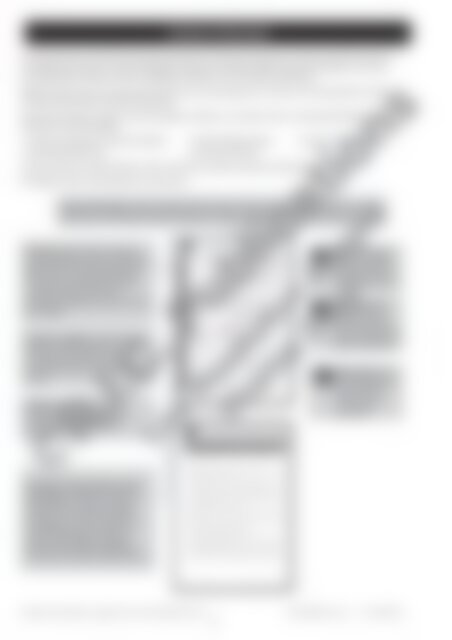20895 ACE Language (Yr 6) Structures and Language Features
You also want an ePaper? Increase the reach of your titles
YUMPU automatically turns print PDFs into web optimized ePapers that Google loves.
Format of the book<br />
This teacher resource book includes supporting materials for teaching <strong>and</strong> learning in the sub-str<strong>and</strong> of Text structure<br />
<strong>and</strong> organisation within the str<strong>and</strong> of <strong>Language</strong> in Australian Curriculum English. All content descriptions in the substr<strong>and</strong><br />
have been included, as well as teaching points based on the Curriculum’s elaborations.<br />
While the book focuses on the sub-str<strong>and</strong> of Text structure <strong>and</strong> organisation, activities <strong>and</strong> interrelated links to other<br />
str<strong>and</strong>s <strong>and</strong> sub-str<strong>and</strong>s have been incorporated.<br />
Each section supports a specific content description <strong>and</strong> follows a consistent format, containing the following<br />
information over several pages:<br />
• activites to develop the content descriptions • student blackline masters • resource sheets<br />
• interrelated English links<br />
• assessment checklist<br />
Answers relating to student blackline masters have been included at the back of the book.<br />
The length of each content description section varies.<br />
Teacher information includes background information relating to the content description, as well as<br />
related terms <strong>and</strong> desirable student vocabulary <strong>and</strong> other useful details which may assist the teacher.<br />
Related terms includes vocabulary<br />
associated with the content description.<br />
Many of these relate to the glossary<br />
in the back of the official Australian<br />
Curriculum English document;<br />
additional related terms may also have<br />
been added.<br />
Student vocabulary includes words<br />
which the teacher would use—<br />
<strong>and</strong> expect the students to learn,<br />
underst<strong>and</strong> <strong>and</strong> use—during English<br />
lessons.<br />
Further resources by R.I.C.<br />
Publications ® or other publishers<br />
or authors are included where<br />
appropriate.<br />
Text structure<br />
<strong>and</strong> organisation<br />
Underst<strong>and</strong> how authors often innovate on text structures <strong>and</strong> play Activities to<br />
with language features to achieve particular aesthetic, humorous <strong>and</strong><br />
persuasive purposes <strong>and</strong> effects (<strong>ACE</strong>LA1518)<br />
develop the<br />
© Australian Curriculum: Assessment <strong>and</strong> Reporting Authority 2012 content description<br />
?<br />
?<br />
What this means<br />
provides a general<br />
explanation of the<br />
content description.<br />
Teaching points<br />
provides a list of<br />
the main teaching<br />
points relating to the<br />
content description.<br />
Elaborations are a<br />
list of elaborations<br />
based on those<br />
in the content<br />
description.<br />
E1. Analyse <strong>and</strong> compare some elements of the text structure <strong>and</strong> language features of a range of texts,<br />
to identify the reasons for the writers’ choices.<br />
• Text types resource pages (pages 6 to 9)<br />
Some elements of the purpose, structure <strong>and</strong> language features of the following text types are summarised in tables on these four resource pages.<br />
• Narratives • Procedures • Recounts • Expositions<br />
• Explanations • Reports • Discussions • Descriptions<br />
Students at this stage should be expected to be familiar with some of the elements of different text types. But they also need to realise that few texts<br />
would exactly ’fit’ one of these.<br />
However, this type of information should be a helpful reference for students when they are looking at texts in order to identify <strong>and</strong> underst<strong>and</strong> some<br />
of the different choices a writer has made <strong>and</strong> why. They need to realise how much influence the intended audience <strong>and</strong> the purpose for writing a text<br />
influence writers’ choices <strong>and</strong> the text structure <strong>and</strong> language features they use.<br />
• Young cyclist remains in coma (Page 10) <strong>and</strong> Glen Wallace Primary School newsletter (page 11)<br />
The texts on these two resource sheets refer to the same incident. There are two activity pages based on these texts in which students are required to<br />
analyse, compare <strong>and</strong> contrast them <strong>and</strong> to identify the purpose for which they were written, some of the choices made by the writers <strong>and</strong> why they<br />
made them. (See pages 12 <strong>and</strong> 13.)<br />
The fi rst text is a newspaper report written to provide detailed information about an accident <strong>and</strong> to attract a reader’s interest with an attentiongrabbing<br />
headline. The text is written in the past tense, in the third person <strong>and</strong> there is some quoted speech from a witness <strong>and</strong> reported speech from<br />
the victim. Its purpose is to report to a wide audience <strong>and</strong> this is reflected in the language used. However, it could be argued that this text is in fact<br />
persuasive, because after reading it, many people may be more concerned <strong>and</strong> vigilant about their family members wearing bike helmets.<br />
By contrast, the second text is the victim’s personal account of the accident <strong>and</strong> what followed. It describes its impact on the victim, his family <strong>and</strong><br />
friends <strong>and</strong> was written to be included in a school newsletter for other students to read. It is an example of persuasive text in the form of a recount. Its<br />
purpose is to persuade others to always wear their bike helmets, but the writer’s position isn’t stated at the beginning of the text, as is usually the case.<br />
In the form of a recount, it is written in the past tense <strong>and</strong> in the first person. In common with other persuasive texts, it uses emotive language <strong>and</strong><br />
modal verbs of obligation <strong>and</strong> advice.<br />
• How hovercraft work (page 14) <strong>and</strong> Dance of the hovercraft (page 15)<br />
These two texts both refer to hovercraft. The two activities pages in which students analyse, compare <strong>and</strong> contrast them are on pages 16 <strong>and</strong> 17.<br />
The fi rst text is an explanation about how a hovercraft works. Its purpose is to explain something as clearly <strong>and</strong> as concisely as possible. As is usual with<br />
many explanations, it starts with a definition, includes technical vocabulary, provides clear, concise information in a logical sequence, is written in the<br />
third person in the present tense, links cause <strong>and</strong> effect <strong>and</strong> includes an evaluative comment <strong>and</strong> a diagram. The information is presented in paragraphs<br />
organised in a logical order.<br />
By contrast the second text is a descriptive recount. It provides relevant background information to orient the reader, describes signifi cant events in<br />
chronological order, is written in the first person in the past tense, uses descriptive, imaginative <strong>and</strong> metaphorical language <strong>and</strong> similes, encourages<br />
visual imagery, is organised in paragraphs <strong>and</strong> concludes with an evaluative comment.<br />
• Coyote (Canis latrans) (page 18) <strong>and</strong> Dogs’ tails - A traditional tale (page 19)<br />
These two texts are about coyotes <strong>and</strong> there are two related activity pages. (pages 20 <strong>and</strong> 21)<br />
The fi rst text is a report on the species. It is set out similarly to many reports starting with an introduction with a defi nition, followed by relevant<br />
information, organised in a logical manner under appropriate subheadings. Students should underst<strong>and</strong> that the purpose of organising text in this<br />
way is to make it easier for a reader to locate specific information. This is because readers may not require all the information presented in the report<br />
<strong>and</strong> they often have to find what they do need in the most efficient way possible. The report is written in the present tense <strong>and</strong> has subject-specific<br />
vocabulary, one word of which has been defined within the text.<br />
The second text is a narrative. It provides orienting information about the time, place <strong>and</strong> characters. The complication is explained <strong>and</strong> fi nally the<br />
resolution is described. The vocabulary may challenge some students, but it is generally supported by the context within the story. A narrative is often<br />
written to entertain <strong>and</strong> amuse, <strong>and</strong> unlike a report, it is not always necessary for a reader of narrative to underst<strong>and</strong> every word. Readers will often<br />
be able to continue to read <strong>and</strong> to maintain some level of interest <strong>and</strong> underst<strong>and</strong>ing of narrative text with a good idea of the gist of the story. Time<br />
connectives make the text more cohesive. It is made more descriptive by the choice of action verbs in the past tense, many with adverbs to further<br />
enhance their meaning. Some readers may find the visual image evoked by the concluding statement humorous. This was the intention of the writer.<br />
Activities to develop the content<br />
description includes descriptions or<br />
instructions for activities or games<br />
relating to the content descriptions<br />
or elaborations. Some activities are<br />
supported by blackline masters or<br />
resource sheets. Where applicable,<br />
these will be stated for easy reference.<br />
R.I.C. Publications® www.ricpublications.com.au Australian Curriculum English – <strong>Language</strong>: Text structure <strong>and</strong> organisation (Year 6)<br />
3<br />
Australian Curriculum English – <strong>Language</strong>: Text structure <strong>and</strong> organisation (Year 6) www.ricpublications.com.au R.I.C. Publications ®<br />
iv


















